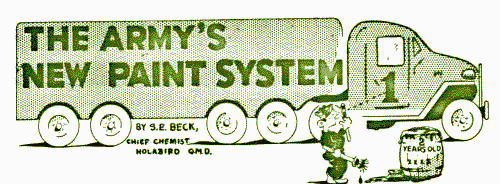
- Not so long ago, Army paints were carefully selected for their gloss. Paints which did not shine brilliantly enough were rejected. ‘Spit and Polish’ was the watch word. In some cases machines were purchased to polish lacquer films to a dazzling lustre. Today, shiny paint is only a memory. Army planners, before the European war began, recognized the need for a new type of paint for tactical vehicles. Before the Defense Program had even hit low gear, the new paint specifications were tested and ready. But the Army had dropped a bombshell in the paint world.As one startled paint expert put it, “the Army has a paint job that’s two years old before it’s on one day.” From many points of view that statement was true. The traditional functions of vehicle paint are twofold:
- To beautify the vehicle.
- To protect the metal surface from rusting.
The Army has forgotten about shining beauty and emphasized the camouflage aspect. Rust prevention is only a secondary consideration.
The camouflage plan that is at present employed on Army vehicles utilizes three factors: color, gloss and stenciling.
COLOR
Vehicles are finished in a solid olive drab color, which was chosen to blend in reasonably well with the average landscape. This color when moistened is a close match to the old glossy olive drab color.
GLOSS
It is coon knowledge that a vehicle painted with ordinary glossy paint can be detected in bright sun light from a surprising distance because of its gleam. The new lustreless paint makes a vehicle difficult to see from the air or from great distances over land.
STENCILING
In addition to these two camouflage effects, the paint system now used by the Army includes a third improvement. White stencil numbers have been eliminated. This was dome because they can be photographed from thin air, as was demonstrated in recent maneuvers. The blue drab stencil enamel, which is now used, cannot be photographed from the air, even using yellow or red filters. Furthermore, it is illegible to the normal eye at distances exceeding seventy-five feet.
NEW PAINT REQUIRES CARE
In order to preserve these camouflage features, more care must be taken with vehicles. To secure the necessary degree of dullness, it was necessary to adapt a relatively rough paint. A dried coat of this paint contains thousands of angular particles of pigment which break up the surface so that a minimum of light is reflected. It is obvious that continued friction or rubbing will eventually smooth down the surface and produce a reflecting finish. This must be avoided at all costs. Careless washing is one of the principal causes of glossing-up. The vehicle should not be washed more than once a week. Pains should be taken to see that the washing is done entirely with a sponge or soft rag. The surface should never be rubbed or wiped, except while wet, or a gloss will be developed.
Continual friction of wax—treated tarpaulin on the sides of a vehicle will also produce a gloss. This may be removed by washing with degreasing solvent. (Covered by QM Spec. ES—No. 398 of latest issue. This material is on contract and may be purchased against Contract Bulletin No.88).
It is not necessary to keep the new lustreless vehicles as scrupulously clean as was customary when glossy paint was used. In fact, a certain amount of dust increases the camouflage value of the paint.
Grease spots should be tolerated, as far as possible. The relatively porous paint soaks up oil as a blotter absorbs ink. Whatever portion of the grease spot cannot be removed by washing with degreasing solvent, should be allowed to remain.
TENDENCY TO FADE
The new paint has more tendency to fade. Each organization should provide itself with standard color chips of the olive drab color and the blue drab color. These standards may be obtained from the Engineering Division, Holabird Quartermaster Depot, Baltimore, Maryland. When the color has faded until it is definitely lighter than the standard, much of the camouflage value is gone and repainting is necessary. Tests at Holabird indicate that repainting will probably be needed once yearly in the case of the olive drab and twice yearly in the case of the blue drab enamel.
The secondary purpose of vehicle paint, rust prevention, is taken care of by a primer. It was found that lustreless olive drab enamel was too porous and insufficiently adhesive to provide adequate protection over an ordinary primer. This new primer has extraordinary water-resistance and adhesion, and Is used under the olive drab enamel on all Army vehicles. Its special values are utilized only where it is applied directly over the bare metal. Consequently, it is not suitable for use as a refinishing primer over old paint coats. This subject will be treated in detail in a later article on repainting.
The lustreless olive drab enamel referred to in this article is covered by Quartermaster Corps Tentative Specification ES 474 of latest issue.
The primer mentioned is covered by Quartermaster Corps Tentative Specification ES-359 of latest Issue.
Both of these paints should be thinned with Thinner and Diluents, Synthetic, covered by Quartermaster Corps Tentative Specification ES-370 of latest issue.
These materials are on contract and may be purchased against Contract Bulletin No. 104 in Zones 1, 2 and 4 or Contract Bulletin No. 94 in Zone 3.
Disclaimer: If you don’t know paint from shinola (like me) then this might be of interest to you. Of course, bear in mind that chemicals and approved use of chemicals have changed over the last 60 years so if you plan on using this information do so with a grain of salt and much caution. I guess just like we don’t use carbon tet in fire extinguishers any more…
